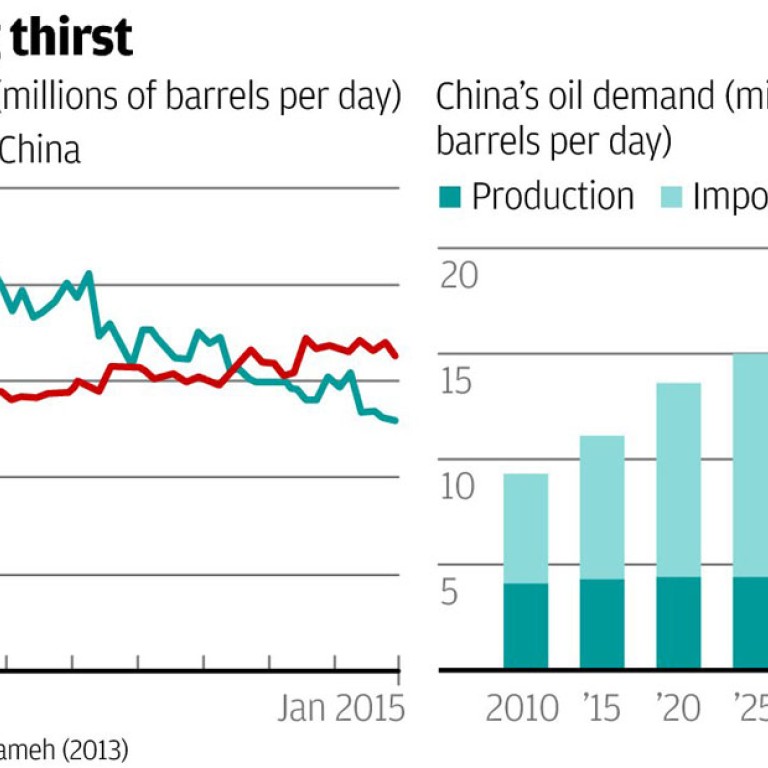
Oil price heading for US$200 as China's imports set to surge
With the mainland’s voracious demand, World Bank consultant projects steady climb in prices, and that will hurt global economic growth
Last month, China passed another milestone in its economic development, although not an auspicious one.
In September, China overtook America as the largest buyer of oil on the international markets.
According to the Energy Information Administration of the US government, last month China's net oil imports hit an average 6.3 million barrels a day, surpassing the US, which imported 6.2 million barrels a day (see the first chart).
China has long boasted the world's fastest growing thirst for oil. In 1996, it accounted for just 5 per cent of the world's demand. By last year, thanks to years of double-digit growth, China's share of global oil demand had more than doubled to 11 per cent.
That trend isn't going to change direction any time soon. Although China's overall growth rate is set to slow over the next few years, it is likely Chinese consumer demand will continue to grow rapidly as household incomes rise. And it is consumer demand, in the form of ballooning sales of private cars, that is driving China's demand for oil.
According to Simon Powell, the head of oil and gas research at brokerage house CLSA, 10 million new cars will hit China's roads each year for the next 10 years. What's more, the fastest growing sector of the market, with sales accelerating by 25 per cent a year, is for fuel-guzzling four-wheel drive monsters.
As a result, China's demand for oil will continue to surge, rising from about 10 million barrels a day this year to almost 18 million per day by 2035, according to forecast compiled by World Bank consultant Mamdouh Salameh.
Nearly all of the extra oil will have to be imported. Despite heavy investment in domestic fields, China lacks the reserves to meet all but a fraction of its future demand from its own wells. This year, China is expected to produce about 4.2 million barrels of oil a day; an amount that will barely change over the next 20 years.
That means net imports are set to soar from 58 per cent of consumption this year to 72 per cent by 2035, equivalent to an extra 6.6 million barrels of oil imports every day (see the second chart).
In other words, China's oil imports will more than double over the next 20 or so years.
That's going to squeeze global supplies.
In the past, the Organisation of the Petroleum Exporting Countries maintained a comfortable cushion of spare capacity, but that has now fallen to just one million barrels a day. Worse, Opec's biggest producer, Saudi Arabia, has no plans to raise its production capacity over the next few years, implying an increasing upward pressure on prices.
"In the future, China will have to outbid the rest of the world for oil supplies, forcing up oil prices," warns Salameh.
Under an optimistic scenario, in which no political upheavals affect markets and new supplies continue to come on stream from Brazilian and Angolan offshore deposits, Canadian tar sands and American oil shales, Salameh reckons the price of oil would continue to hover between US$100 and US$130 a barrel for the remainder of this decade.
But in reality, with supplies tight and politics unpredictable, "prices will continue to spike over the next five years, occasionally reaching US$200 per barrel", he predicts.
That's going to hurt. Salameh argues the world can afford to spend at most 6 per cent of global gross domestic product on oil , which equates to an average price of no more than US$137 in 2015, or US$156 in 2020. Any more than that - which looks highly likely given the strength of Chinese demand - and global economic growth will begin to suffer.
The good news is that the world is not short of oil. But Salameh estimates it will take investment of more than US$13 trillion between now and 2030 to ensure sufficient supplies.
The only way that's going to be forthcoming is if prices rise.

